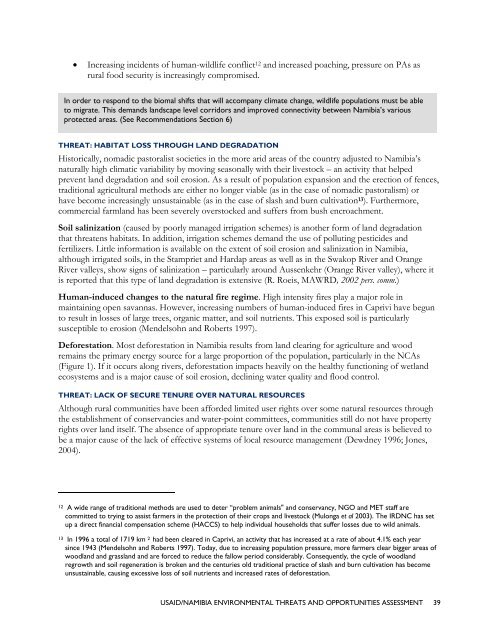usaid/nambia environmental threats and opportunities assessment
usaid/nambia environmental threats and opportunities assessment
usaid/nambia environmental threats and opportunities assessment
You also want an ePaper? Increase the reach of your titles
YUMPU automatically turns print PDFs into web optimized ePapers that Google loves.
Increasing incidents of human-wildlife conflict 12 <strong>and</strong> increased poaching, pressure on PAs as<br />
rural food security is increasingly compromised.<br />
In order to respond to the biomal shifts that will accompany climate change, wildlife populations must be able<br />
to migrate. This dem<strong>and</strong>s l<strong>and</strong>scape level corridors <strong>and</strong> improved connectivity between Namibia’s various<br />
protected areas. (See Recommendations Section 6)<br />
THREAT: HABITAT LOSS THROUGH LAND DEGRADATION<br />
Historically, nomadic pastoralist societies in the more arid areas of the country adjusted to Namibia’s<br />
naturally high climatic variability by moving seasonally with their livestock – an activity that helped<br />
prevent l<strong>and</strong> degradation <strong>and</strong> soil erosion. As a result of population expansion <strong>and</strong> the erection of fences,<br />
traditional agricultural methods are either no longer viable (as in the case of nomadic pastoralism) or<br />
have become increasingly unsustainable (as in the case of slash <strong>and</strong> burn cultivation 13 ). Furthermore,<br />
commercial farml<strong>and</strong> has been severely overstocked <strong>and</strong> suffers from bush encroachment.<br />
Soil salinization (caused by poorly managed irrigation schemes) is another form of l<strong>and</strong> degradation<br />
that threatens habitats. In addition, irrigation schemes dem<strong>and</strong> the use of polluting pesticides <strong>and</strong><br />
fertilizers. Little information is available on the extent of soil erosion <strong>and</strong> salinization in Namibia,<br />
although irrigated soils, in the Stampriet <strong>and</strong> Hardap areas as well as in the Swakop River <strong>and</strong> Orange<br />
River valleys, show signs of salinization – particularly around Aussenkehr (Orange River valley), where it<br />
is reported that this type of l<strong>and</strong> degradation is extensive (R. Roeis, MAWRD, 2002 pers. comm.)<br />
Human-induced changes to the natural fire regime. High intensity fires play a major role in<br />
maintaining open savannas. However, increasing numbers of human-induced fires in Caprivi have begun<br />
to result in losses of large trees, organic matter, <strong>and</strong> soil nutrients. This exposed soil is particularly<br />
susceptible to erosion (Mendelsohn <strong>and</strong> Roberts 1997).<br />
Deforestation. Most deforestation in Namibia results from l<strong>and</strong> clearing for agriculture <strong>and</strong> wood<br />
remains the primary energy source for a large proportion of the population, particularly in the NCAs<br />
(Figure 1). If it occurs along rivers, deforestation impacts heavily on the healthy functioning of wetl<strong>and</strong><br />
ecosystems <strong>and</strong> is a major cause of soil erosion, declining water quality <strong>and</strong> flood control.<br />
THREAT: LACK OF SECURE TENURE OVER NATURAL RESOURCES<br />
Although rural communities have been afforded limited user rights over some natural resources through<br />
the establishment of conservancies <strong>and</strong> water-point committees, communities still do not have property<br />
rights over l<strong>and</strong> itself. The absence of appropriate tenure over l<strong>and</strong> in the communal areas is believed to<br />
be a major cause of the lack of effective systems of local resource management (Dewdney 1996; Jones,<br />
2004).<br />
12 A wide range of traditional methods are used to deter “problem animals" <strong>and</strong> conservancy, NGO <strong>and</strong> MET staff are<br />
committed to trying to assist farmers in the protection of their crops <strong>and</strong> livestock (Mulonga et al 2003). The IRDNC has set<br />
up a direct financial compensation scheme (HACCS) to help individual households that suffer losses due to wild animals.<br />
13 In 1996 a total of 1719 km 2 had been cleared in Caprivi, an activity that has increased at a rate of about 4.1% each year<br />
since 1943 (Mendelsohn <strong>and</strong> Roberts 1997). Today, due to increasing population pressure, more farmers clear bigger areas of<br />
woodl<strong>and</strong> <strong>and</strong> grassl<strong>and</strong> <strong>and</strong> are forced to reduce the fallow period considerably. Consequently, the cycle of woodl<strong>and</strong><br />
regrowth <strong>and</strong> soil regeneration is broken <strong>and</strong> the centuries old traditional practice of slash <strong>and</strong> burn cultivation has become<br />
unsustainable, causing excessive loss of soil nutrients <strong>and</strong> increased rates of deforestation.<br />
USAID/NAMIBIA ENVIRONMENTAL THREATS AND OPPORTUNITIES ASSESSMENT 39

















